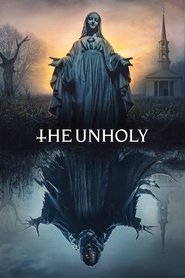

Nightmares of a neon red-pearl creek and an arachnid walking ghoul in rotting robes haunt Fenn.

As word of Alice’s miracles spread, and the world flocks to Banfield, Natalie (Katie Aselton), a doctor Fenn comes to trust Alice’s protective uncle, Father Hagen (William Sadler) and Fenn himself grow weary of the innocent girl’s growing fame. The film’s rigid frights beat noisily against these oxygen-sucking characters. But Spiliotopoulos holds a firmer gaze on Fenn, while clumsily balancing his character’s heavy exposition with the church’s significant history involving demonic possession. These narrative interrogations in a post-Trump, clergy child-sex-abuse scandalworld invites profound answers. Both the fame-hungry Fenn and the church see Alice as a path to re-win hearts and minds. Through a conniving Bishop Gyles (Cary Elwes) and a swaggering Monsignor Delgarde (Diogo Morgado), sent by the Catholic Church to confirm the tree as a holy shrine, Spiliotopoulos critiques trusted institutions, the church and the press, and their status as arbiters of truth. Spiliotopoulos stultifies “The Unholy” by wrapping the thematic garments of a journalistic thriller, and the pins of religious horror, for a mismatched outfit that unravels when worn. The gawking lens, further hindered by the uneasy sound of the child’s legs uncrumpling, as though he was grotesque before, offers a cheap trade in body horror. For instance: He engineers a healing scene wherein Alice gives a wheelchair user, a boy with muscular dystrophy, the ability to walk again. The very ‘80s premise, replete with a magical disabled person trope, hampers Spiliotopoulos. And in Alice’s newfound abilities, Fenn - one moment a supportive father figure to Alice, the next a skulking opportunist - smells fame. The radiant specter infuses Alice with healing powers, miracles she can perform if the people merely invest full-throated faith in Mary. In a serpentine whisper, the seemingly heavenly being claims to be the Virgin Mary. A deaf-mute teen born with congenital cholesteatoma, Alice wanders away to pray to the oak tree, suddenly gaining the ability to hear and speak from a blindly white apparition. But he imbues this shill with too much charm, too heavy of a collective cool beneath the pristine winter beard and beguiling sunglasses to totally encapsulate the myriad contradictions within this character.ĭreadful consequences following his reckless actions arise when his car nearly hits a white-gowned Alice (Cricket Brown) in the middle of the road. With credits in “Supernatural” and “The Walking Dead,” Morgan should be the perfect choice to play the morally ambiguous Fenn. Fenn mercilessly smashes the doll - thereby breaking the area’s peace. Providence, he believes, gazes upon him when in a trunk of petrified oak he finds a rotting chained kern doll, used by farmers for good luck, marked with an impossible date: Feb. In several ways, Fenn wouldn’t be where he is if he allowed the facts to stop him. Upon arriving at the simple farm, the unrelentingly charismatic Fenn, a cynical jerk living in a bottle, discovers a non-story. Raised by rope, flames engulfing her sights, a priest holds a puritan porcelain doll taunting the familiar promise of a story involving wrongfully accused witches and judicial skullduggery - an early narrative fakeout.įast-forward to present-day Boston, and Gerry Fenn (Jeffrey Dean Morgan), a once-renowned reporter now working a clickbait beat for a pittance, hears of cow mutilations occurring in the quaint Massachusetts town of Banfield, a sleepy uneventful corner of the old-world state. Behind the view of an iron mask, an unknown woman’s cries are muffled the fleshy explosions emanating from a mallet striking her metal visage fills our ears with the archaic scene. Laboriously paced, the indulgent jolts and bloodless scares, neither deeply rooted nor artfully raised, float as lifelessly as a lily pad on a bog.Īdapted from James Herbert’s 1983 novel “Shrine,” Spiliotopoulos, who previously wrote fantastical tentpoles like “Beauty and the Beast” (2017) and “The Huntsman: Winter’s War,” opens “The Unholy” in 1845. Set in an eerie, isolated, present-day New England town, “The Unholy” is a work of gothic terror operating in the religious horror model - a film owing deeply to “The Nun” and “The Exorcist.” A directorial debut for Evan Spiliotopoulos, the dramatically muddled demonic possession narrative inertly smears frights of “fake news,” mass hysteria and faith healing onto a sporadically interesting folkloric landscape - formulating a narrative lacking in the psychological pull necessary to bind these rich elements together.


 0 kommentar(er)
0 kommentar(er)
